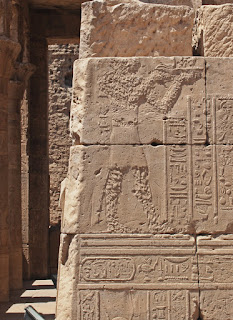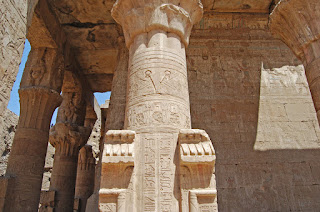Birth House
Mammisi
Mammisi, Mamisi
These were small temples, attached to the main temples of the Ptolemaic and Roman Period. There the god of the main temple was born, or if the main temple was dedicated to a goddess it was where she bore her children. The interior walls usually record scenes from the divine marriage and the king's birth.
The idea of the birth-house had begun during the reign of Hatshepsut, in The Deir-el-Bahari Temple , to justify her coronation as a pharaoh in spite of her being a woman. This concept was also used by the Greek Ptolemaic Kings to gain legitimacy
The only persons allowed to be present at these rituals were the king and certain members of the priesthood.
For and after the birth of her child, the mother withdrew to a special location outside the house for a ritual purification period of (at least) two weeks. This was often placed on the roof of the house and ... was often shaped like a tabernacle: a construction of poles with convolvulus
[morning glory] and vines growing up them.
Egyptologists disagree about whether these birth huts were the predecessors of the so-called birth houses
(also called by the modern designation mammisi)
known from a number of temples from the Ptolemaic period. The best known are those from Dendera, Edfu and Philae. They are always chapels situated in front of the main temple, to one side of the main axis and perpendicular to it.
Gods commonly connected with the protection of mother and child, such as Bes and Taweret, are also often depicted in the birth houses.
The mammisi, which is often referred to as a birth house and considered by some to be a temple in its own rite, was certainly a structure with considerable religious significance, especially for the king.
This term, which is actually a coptic word for "birth-place," was originally invented for the structure by Jean Francois Champollion
[of Rosetta Stone fame].
Located within the temple precinct and often oriented at right angles to the main temple axis, this type of structure was associated with the mysterious birth of the gods and the celebration of their births. Particularly in New Kingdom mammisis, the divine birth of the king might also be celebrated. While the birth of a god, such as Horus the Younger was primary in the mammisi, the king's divine relationship with the gods is also frequently stressed.
Mammisis were very common in the Greek and Roman period, when they were present in all known, major temples, but their origin was probably Egypt's Late Period. However, there appears, evidenced by 18th Dynasty reliefs describing the divine birth of Hatshepsut at Deir el-Bahri and that of Amenhotep III at Luxor, to have been earlier counterparts.
-----
Mark Andrews
Ancient Egyptian Temple Elements
Part V: Associated Element
بيت الميلاد
Mammisi
مامسيسي ، ماميسي
كانت هذه معابد صغيرة ملحقة بالمعابد الرئيسية في العصر البطلمي والروماني. هناك ولد إله المعبد الرئيسي ، أو إذا كان المعبد الرئيسي مخصصًا للإلهة ، حيث كانت تحمل أطفالها. الجدران الداخلية عادة ما تسجل مشاهد من الزواج الإلهي وولادة الملك.
كانت فكرة دار الولادة قد بدأت في عهد حتشبسوت ، في معبد الدير البحري ، لتبرير تتويجها كفرعون على الرغم من كونها امرأة. تم استخدام هذا المفهوم أيضا من قبل الملوك البطالمة اليونانيين لكسب الشرعية
الأشخاص الوحيدون المسموح لهم بالحضور في هذه الطقوس كانوا الملك وبعض أعضاء الكهنوت.
وبعد ولادة طفلها ، انسحبت الأم إلى موقع خاص خارج المنزل لفترة تطهير طقسي (على الأقل) أسبوعين. كان هذا غالباً ما يوضع على سطح المنزل و ... كان غالباً ما يشبه مسكن: بناء أعمدة مع اللبلاب
[مجد الصباح] وكروم ترعرعهم.
يختلف علماء المصريات حول ما إذا كانت أكواخ الولادة هذه هي أسلاف ما يسمى بيوت الولادة
(وتسمى أيضا من قبل mammisi التسمية الحديثة)
معروفة من عدد من المعابد من العصر البطلمي. أشهرها هي تلك الموجودة في دنديرا وإدفو وفيلة. هم دائما مصليات تقع أمام المعبد الرئيسي ، إلى جانب واحد من المحور الرئيسي ومتعامدة على ذلك.
الآلهة المرتبطة عادة بحماية الأم والطفل ، مثل بيس وتورايت ، غالبا ما يتم تصويرها في بيوت الولادة.
كان المومسي ، الذي غالباً ما يشار إليه على أنه منزل ولادة ويعتبره البعض معبدًا في طقوسه الخاصة ، بالتأكيد بنية ذات أهمية دينية كبيرة ، خاصة للملك.
هذا المصطلح ، الذي هو في الواقع كلمة قبطية لـ "مكان الميلاد" ، اخترع في الأصل للهيكل جان فرانسوا شامبليون
[من حجر رشيد الشهرة].
تقع داخل منطقة المعبد وغالبا ما تكون موجهة في زوايا قائمة على محور المعبد الرئيسي ، ويرتبط هذا النوع من الهيكل مع ولادة الآلهة الغامضة والاحتفال بميلادهم. ولا سيما في الماموثية في المملكة الحديثة ، قد يتم الاحتفال بالولادة الإلهية للملك. في حين أن ولادة الإله ، مثل حورس الأصغر كانت أساسية في المامسي ، فإن علاقة الملك الإلهية مع الآلهة يتم التأكيد عليها بشكل متكرر.
كانت ماميسس شائعة جدا في العصر اليوناني والروماني ، عندما كانت موجودة في جميع المعابد الكبرى المعروفة ، ولكن أصلها ربما كان العصر المصري المتأخر. ومع ذلك ، يبدو أن هناك ما يشير إلى النقوش التي تعود إلى القرن الثامن عشر والتي وصفت الولادة الإلهية لحتشبسوت في دير البحري ومدينة أمنحتب الثالث في الأقصر ، إلى نظراء سابقين.
-----
مارك اندروز
عناصر المعبد المصري القديم
الجزء الخامس: العنصر المرتبط
Mammisi
Mammisi, Mamisi
These were small temples, attached to the main temples of the Ptolemaic and Roman Period. There the god of the main temple was born, or if the main temple was dedicated to a goddess it was where she bore her children. The interior walls usually record scenes from the divine marriage and the king's birth.
The idea of the birth-house had begun during the reign of Hatshepsut, in The Deir-el-Bahari Temple , to justify her coronation as a pharaoh in spite of her being a woman. This concept was also used by the Greek Ptolemaic Kings to gain legitimacy
The only persons allowed to be present at these rituals were the king and certain members of the priesthood.
For and after the birth of her child, the mother withdrew to a special location outside the house for a ritual purification period of (at least) two weeks. This was often placed on the roof of the house and ... was often shaped like a tabernacle: a construction of poles with convolvulus
[morning glory] and vines growing up them.
Egyptologists disagree about whether these birth huts were the predecessors of the so-called birth houses
(also called by the modern designation mammisi)
known from a number of temples from the Ptolemaic period. The best known are those from Dendera, Edfu and Philae. They are always chapels situated in front of the main temple, to one side of the main axis and perpendicular to it.
Gods commonly connected with the protection of mother and child, such as Bes and Taweret, are also often depicted in the birth houses.
The mammisi, which is often referred to as a birth house and considered by some to be a temple in its own rite, was certainly a structure with considerable religious significance, especially for the king.
This term, which is actually a coptic word for "birth-place," was originally invented for the structure by Jean Francois Champollion
[of Rosetta Stone fame].
Located within the temple precinct and often oriented at right angles to the main temple axis, this type of structure was associated with the mysterious birth of the gods and the celebration of their births. Particularly in New Kingdom mammisis, the divine birth of the king might also be celebrated. While the birth of a god, such as Horus the Younger was primary in the mammisi, the king's divine relationship with the gods is also frequently stressed.
Mammisis were very common in the Greek and Roman period, when they were present in all known, major temples, but their origin was probably Egypt's Late Period. However, there appears, evidenced by 18th Dynasty reliefs describing the divine birth of Hatshepsut at Deir el-Bahri and that of Amenhotep III at Luxor, to have been earlier counterparts.
-----
Mark Andrews
Ancient Egyptian Temple Elements
Part V: Associated Element
بيت الميلاد
Mammisi
مامسيسي ، ماميسي
كانت هذه معابد صغيرة ملحقة بالمعابد الرئيسية في العصر البطلمي والروماني. هناك ولد إله المعبد الرئيسي ، أو إذا كان المعبد الرئيسي مخصصًا للإلهة ، حيث كانت تحمل أطفالها. الجدران الداخلية عادة ما تسجل مشاهد من الزواج الإلهي وولادة الملك.
كانت فكرة دار الولادة قد بدأت في عهد حتشبسوت ، في معبد الدير البحري ، لتبرير تتويجها كفرعون على الرغم من كونها امرأة. تم استخدام هذا المفهوم أيضا من قبل الملوك البطالمة اليونانيين لكسب الشرعية
الأشخاص الوحيدون المسموح لهم بالحضور في هذه الطقوس كانوا الملك وبعض أعضاء الكهنوت.
وبعد ولادة طفلها ، انسحبت الأم إلى موقع خاص خارج المنزل لفترة تطهير طقسي (على الأقل) أسبوعين. كان هذا غالباً ما يوضع على سطح المنزل و ... كان غالباً ما يشبه مسكن: بناء أعمدة مع اللبلاب
[مجد الصباح] وكروم ترعرعهم.
يختلف علماء المصريات حول ما إذا كانت أكواخ الولادة هذه هي أسلاف ما يسمى بيوت الولادة
(وتسمى أيضا من قبل mammisi التسمية الحديثة)
معروفة من عدد من المعابد من العصر البطلمي. أشهرها هي تلك الموجودة في دنديرا وإدفو وفيلة. هم دائما مصليات تقع أمام المعبد الرئيسي ، إلى جانب واحد من المحور الرئيسي ومتعامدة على ذلك.
الآلهة المرتبطة عادة بحماية الأم والطفل ، مثل بيس وتورايت ، غالبا ما يتم تصويرها في بيوت الولادة.
كان المومسي ، الذي غالباً ما يشار إليه على أنه منزل ولادة ويعتبره البعض معبدًا في طقوسه الخاصة ، بالتأكيد بنية ذات أهمية دينية كبيرة ، خاصة للملك.
هذا المصطلح ، الذي هو في الواقع كلمة قبطية لـ "مكان الميلاد" ، اخترع في الأصل للهيكل جان فرانسوا شامبليون
[من حجر رشيد الشهرة].
تقع داخل منطقة المعبد وغالبا ما تكون موجهة في زوايا قائمة على محور المعبد الرئيسي ، ويرتبط هذا النوع من الهيكل مع ولادة الآلهة الغامضة والاحتفال بميلادهم. ولا سيما في الماموثية في المملكة الحديثة ، قد يتم الاحتفال بالولادة الإلهية للملك. في حين أن ولادة الإله ، مثل حورس الأصغر كانت أساسية في المامسي ، فإن علاقة الملك الإلهية مع الآلهة يتم التأكيد عليها بشكل متكرر.
كانت ماميسس شائعة جدا في العصر اليوناني والروماني ، عندما كانت موجودة في جميع المعابد الكبرى المعروفة ، ولكن أصلها ربما كان العصر المصري المتأخر. ومع ذلك ، يبدو أن هناك ما يشير إلى النقوش التي تعود إلى القرن الثامن عشر والتي وصفت الولادة الإلهية لحتشبسوت في دير البحري ومدينة أمنحتب الثالث في الأقصر ، إلى نظراء سابقين.
-----
مارك اندروز
عناصر المعبد المصري القديم
الجزء الخامس: العنصر المرتبط






















































































ليست هناك تعليقات:
إرسال تعليق